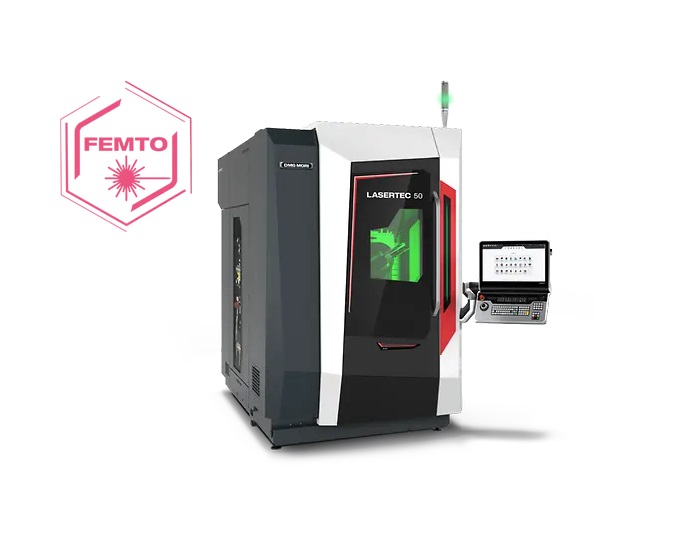Generation of high-end surfaces in high-performance materials up to Ra <0.1 µm with femtosecond laser.
3D laser ablation for the production of miniature molds, extrusion dies, inscriptions and engravings
- Contact-free machining without need of electrodes and without tool wear
- Highest repeatability and reproducability
- Machining of standard materials up to Advanced materials like glass, ceramics and tungsten carbide
- Surface qualities up to Ra < 0,1 µm in carbide tools
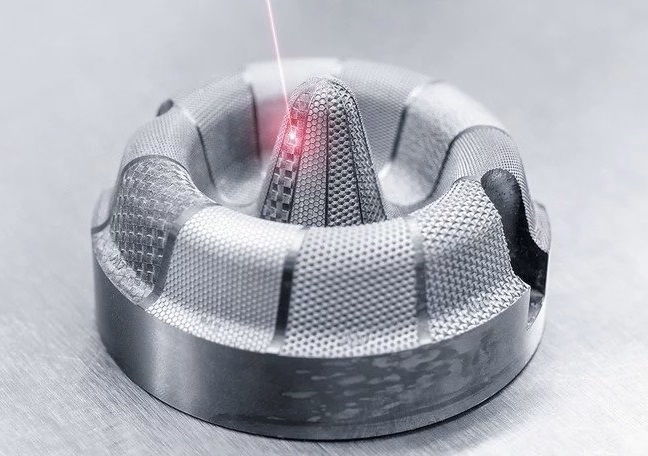
Femtosecond laser technology has several potential applications in plastic injection molding, primarily focused on mold fabrication and surface treatment. Here are some key applications:
-
Mold Fabrication: Femtosecond lasers can be used in the fabrication of injection molds with high precision and intricate features. These lasers are capable of micromachining various materials used in mold making, such as tool steels and ceramics, to create complex geometries, fine details, and precise surface finishes. Femtosecond lasers can be employed for tasks such as cavity and core machining, texturing, engraving, and microstructuring, enabling the production of molds with superior quality and performance.
-
Surface Modification: Femtosecond laser technology can be used to modify the surface properties of injection molds to improve functionality and performance. Laser surface texturing (LST) techniques can create microstructures, patterns, or textures on the mold surface, which can enhance mold release properties, reduce friction, improve cooling efficiency, and optimize part quality. These surface modifications can help mitigate common issues in injection molding, such as sticking, flashing, and flow marks, leading to improved productivity and part quality.
-
Mold Repair and Maintenance: Femtosecond lasers can be utilized for mold repair and maintenance tasks, such as welding, engraving, and polishing. Laser welding techniques can be employed to repair damaged or worn mold components by precisely fusing metal powders or wire onto the affected areas, restoring the mold to its original dimensions and functionality. Laser engraving and polishing can be used for surface refinishing and maintenance, improving mold performance and extending its service life.
-
Injection Molding Process Monitoring: Femtosecond laser-based sensing and measurement techniques can be integrated into injection molding processes for real-time monitoring and quality control. Laser-induced breakdown spectroscopy (LIBS) and laser-induced fluorescence (LIF) are examples of femtosecond laser-based analytical techniques that can analyze molten plastic materials and detect contaminants or defects, ensuring the quality and consistency of molded parts.
-
Conformal Cooling Channels: Femtosecond lasers enable the fabrication of complex and highly efficient conformal cooling channels within injection molds. These channels can be precisely machined directly into the mold inserts, conforming to the contours of the part geometry, and significantly improving heat transfer and cooling uniformity. Conformal cooling channels help reduce cycle times, minimize warpage, and improve part quality, resulting in increased productivity and cost savings.
Overall, femtosecond laser technology offers diverse and promising applications in plastic injection molding, ranging from mold fabrication and surface treatment to process monitoring and quality control. By leveraging the capabilities of femtosecond lasers, manufacturers can enhance mold performance, optimize production processes, and achieve superior quality in injection-molded parts.
APPLICATION EXAMPLES
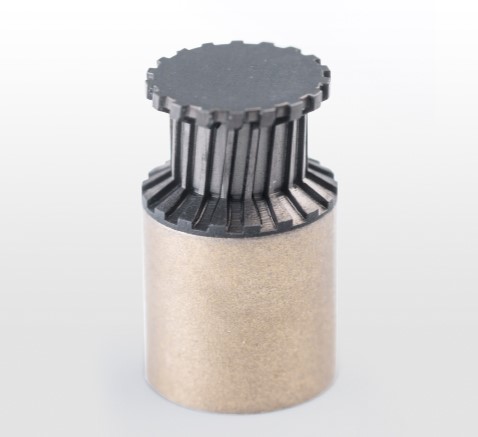
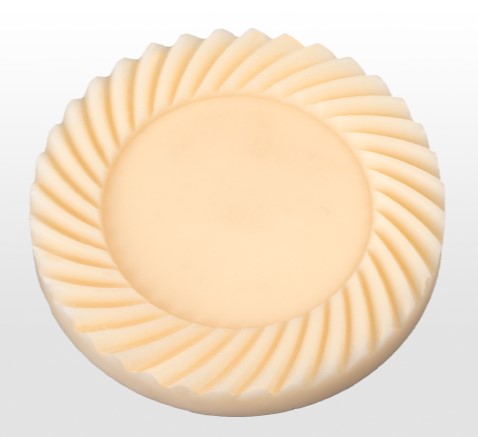
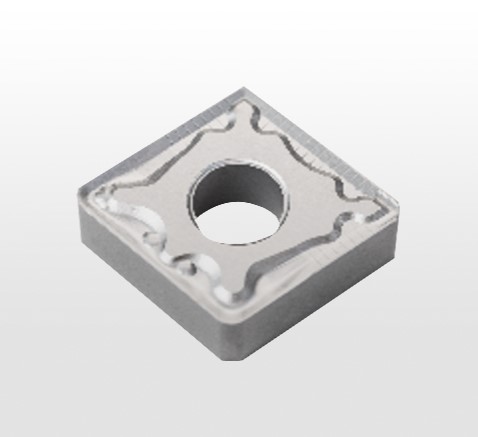
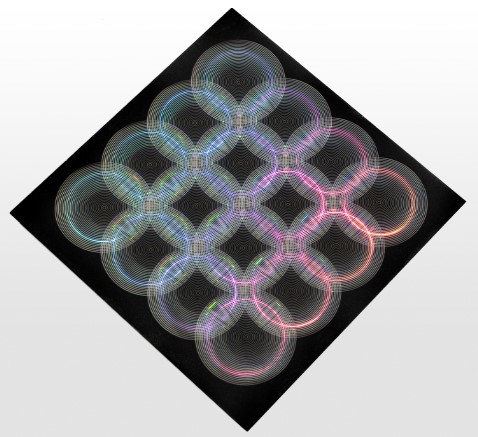
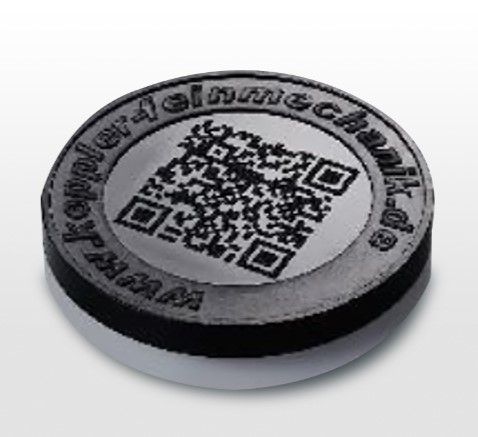
Femtosecond laser technology offers numerous applications in high-precision metalworking, providing unparalleled precision, flexibility, and versatility. Here are some key applications of femtosecond laser technology in high precision metalwork:
-
Micromachining: Femtosecond lasers can precisely ablate or remove material from metal surfaces with sub-micron accuracy. This capability enables the fabrication of intricate features, microstructures, and complex geometries on metal workpieces. Micromachining with femtosecond lasers is utilized in various industries, including aerospace, medical devices, electronics, and automotive, for manufacturing precision components with tight tolerances and fine details.
-
Surface Texturing and Structuring: Femtosecond lasers can create precise surface textures, patterns, and structures on metal surfaces for functional or decorative purposes. Laser-induced periodic surface structures (LIPSS) and other surface texturing techniques can modify surface properties such as wettability, friction, and adhesion, making them suitable for applications such as tribology, microfluidics, and optical devices.
-
Micro-drilling and Micro-cutting: Femtosecond lasers can perform micro-drilling and micro-cutting operations on metal workpieces with high precision and minimal heat-affected zones. These lasers can create holes, slits, or channels with diameters as small as tens of micrometers, making them suitable for applications such as fuel injection nozzles, microfluidic devices, and medical implants.
-
Thin Film Deposition and Ablation: Femtosecond lasers can deposit or ablate thin films or coatings on metal surfaces with precise control over thickness and composition. Laser-based techniques such as pulsed laser deposition (PLD) and laser ablation enable the deposition or removal of thin films for applications such as surface modification, corrosion protection, and functional coatings.
-
Laser Welding and Joining: Femtosecond lasers can perform precision welding and joining of metal parts with minimal distortion and heat-affected zones. These lasers enable spot welding, seam welding, and laser brazing of dissimilar metals, enabling the fabrication of complex assemblies with high strength and reliability. Femtosecond laser welding is used in industries such as automotive, aerospace, and electronics for joining components with tight tolerances and high quality requirements.
-
Laser Cutting and Scribing: Femtosecond lasers can cut, scribe, or mark metal workpieces with high precision and minimal thermal damage. Laser cutting with femtosecond lasers enables the fabrication of intricate shapes, fine features, and high-quality edges in metals such as stainless steel, aluminum, and titanium. Femtosecond laser scribing is used in applications such as microelectronics, photovoltaics, and display technologies for precision patterning and marking of metal substrates.
Overall, femtosecond laser technology offers a wide range of applications in high precision metalwork, enabling manufacturers to achieve unprecedented levels of precision, accuracy, and quality in metal processing and fabrication. By leveraging the capabilities of femtosecond lasers, industries can advance innovation, improve productivity, and meet the demanding requirements of modern manufacturing.
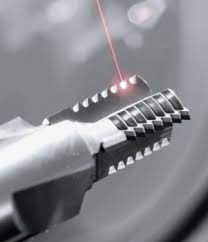
Case Study: Femtosecond Laser Surface Texturing for Plastic Injection Molds
Background: A high-end consumer electronics manufacturer is facing challenges with mold release and surface friction in their plastic injection molding process. They are seeking solutions to improve the quality and consistency of their molded parts while reducing cycle times and minimizing defects such as flow marks and flash.
Problem Statement: The existing injection molds are experiencing issues with poor mold release and surface finish, leading to production delays and increased scrap rates. Traditional mold surface treatments and coatings have provided limited improvement, prompting the need for a more advanced solution to enhance mold performance and part quality.
Solution: The manufacturer decides to explore femtosecond laser surface texturing as a potential solution to address the mold release and surface friction issues. They collaborate with a specialized laser machining service provider to develop and implement a customized surface texturing solution for their injection molds.
Implementation Steps:
-
Design Optimization: The manufacturer works closely with the laser machining service provider to optimize the design of the mold surface texture patterns. They consider factors such as texture density, geometry, and orientation to achieve the desired surface properties, including improved mold release, reduced friction, and enhanced surface aesthetics.
-
Femtosecond Laser Ablation: Using state-of-the-art femtosecond laser systems, the mold surface texture patterns are precisely ablated onto the mold inserts with sub-micron accuracy. The femtosecond laser technology enables the creation of fine features and microstructures with minimal heat-affected zones and surface damage, ensuring superior mold performance and part quality.
-
Surface Characterization and Testing: The textured mold inserts undergo comprehensive surface characterization and testing to evaluate their performance in terms of mold release, surface friction, and part quality. Various test molds are produced using the textured inserts, and injection molding trials are conducted to assess the impact of the surface texture on part properties and production efficiency.
-
Validation and Optimization: Based on the results of the surface characterization and molding trials, the manufacturer validates the effectiveness of the femtosecond laser surface texturing solution in improving mold performance and part quality. Any necessary adjustments or optimizations are made to further enhance the surface texture design and optimize process parameters.
Results: The implementation of femtosecond laser surface texturing results in significant improvements in mold release, surface finish, and part quality. The textured mold inserts demonstrate superior performance in terms of reduced friction, minimized flow marks, and enhanced surface aesthetics. The injection molding process achieves higher productivity, lower scrap rates, and improved overall efficiency, leading to cost savings and enhanced competitiveness for the manufacturer.
Conclusion: Femtosecond laser surface texturing offers a novel and effective solution for enhancing the performance of plastic injection molds. By leveraging the precision and versatility of femtosecond laser technology, manufacturers can overcome challenges related to mold release, surface friction, and part quality, ultimately improving the efficiency and profitability of their injection molding operations.
While this case study represents a hypothetical scenario, it illustrates the potential benefits of applying femtosecond laser technology in plastic injection mold fabrication. As femtosecond laser technology continues to advance and become more accessible, its use in mold-related processes may become more widespread, offering new opportunities for innovation and improvement in injection molding applications.

